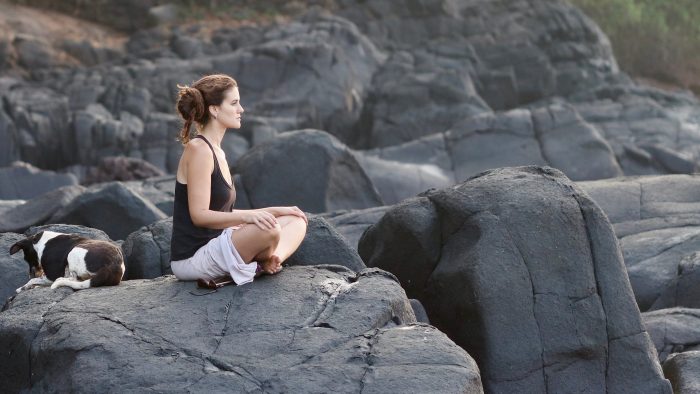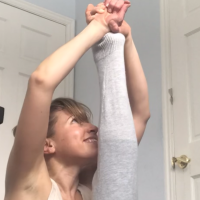Does your home yoga practice count?
I ask this without judgment, and without knowing what a practice that “counts” means for you. For years, mine didn’t really count. I would practice at home sometimes, usually as a last resort, or to sort out the sequence for a class I was planning to teach. Sometimes, I would practice with recordings of classes by my favorite teachers.
But my home practice often felt lame. It was okay, and sometimes sweet, but had none of the excitement and energy of the “real” studio deal.
To be quite honest, my home practice was half-assed.
I grew concerned when I moved from Washington, D.C. out to Loudon County, Virginia a few months ago. In D.C., I’d been adopted by an Ashtanga crowd and had taken to Mysore style Ashtanga as my main practice—finally, after two years of being irregular with it and several more on top of that just flirting with Ashtanga in general. While there is lots of great yoga in my new town, there is no Mysore program.
For a second, I thought my Ashtanga journey might be coming to an end. But my sheer desire for this practice won out, and I had no choice but to make my own home Shala. And in order to make it sustainable, I had to make it count.
How the hell would I manage to recreate the energy, sweat and heat of the Mysore room—so much of which comes from being surrounded by fellow practitioners in the thick of their own demanding practices? Not to mention the presence of a beautiful teacher—in a little room in my own house?
Three months post-move, my private home Shala is a stark raving success. And I have the sweat-soaked yoga clothes and progress getting my legs behind my head (Eka Pada Sirsasana, I’m talking about you) to prove that it counts, man. It freakin’ counts. And I love it.
But, here are a few disclaimers before I get to the nitty-gritty. I’m writing this as a Mysore-style Ashtanga practitioner. And, I am me (a little intense). What that means, for starters, is that a practice that counts to me is sweaty, take-no-prisoners, kick-ass yet also healing and beautiful all in one. Secondly, it’s Mysore-style Ashtanga. I believe that Mysore-style Ashtanga translates well into the home because even in the studio, Mysore practice is always self-practice.
I discovered that I have already been trained by my teachers in this lineage to practice at home alone. But, if you practice another style you may want to keep reading nonetheless, as I think what I have experienced contains some threads of usefulness for any home yogi, even if your style doesn’t involve leaving your mat a sweaty mess in order to “count.”
Finally, I’m not an expert in anything except my own experience, and I am, admittedly, a newly minted ashtangi. I am not a certified or authorized Ashtanga teacher. The only thing I know well is my own practice. When a friend wrote to me with concerns about her own move to a place a good hour away from any Mysore studio, it occurred to me that while I may just be the average practicing ashtangi, there might be plenty of people out there in the same “needing-a-home-practice-that-counts” boat.
Here are my five ways to make your home practice count:
1. Get a room. In other words, get a space you can use at home—preferably a dedicated space. It doesn’t have to be perfect. For example, my space doubles as my two-year old’s bedroom: It’s small (and easy to heat), has good floors, windows, and light. Significantly, the ritual of using this room is set. If you used to practice regularly at a studio, you may recall that going to that space was your ritual. Using the same room helps to imbue your home space with that same feeling.
I recently read a document written by a respected Ashtanga teacher. In it, she speaks of “triggers” for practice, like the sound of turning your key and firing up your car to head to the studio. Though I practice at home, I have yet to roll out of bed and practice in lingerie like the lovely woman in that Equinox video. I need some “wake up and practice” triggers, like a regular morning practice time, coffee, a shower and maybe a quick bonus walk for the dogs to get some fresh air, just like I used to get when I had to head outside to bike or drive to practice.
2. Give your studio your optimal conditions. The good news about practicing at home is that you are in charge. You set the time for practice; you set the conditions. Have I mentioned that I like heat? At my teacher’s studio, the Mysore room seems to be part swamp. And part of that is due to the intense energy radiating off all of those hard-working bodies. How to make this happen at home, solo?
I use a micathermic space heater and a good humidifier set to a high percentage (a little less now that we’re deep in summer). Sure, we bought the humidifier at the recommendation of my doula for the baby, but who says it can’t have a new life as a Mysore/swamp-room creator now? It works.
Maybe you prefer less heat. Well, you’re the boss.
But that, as well as all of the above, of course, is subject to my tip about needing a teacher (number four, below). I have found that I get the most out of my practice when I observe the rules and etiquette of the Mysore studios I have been to.
If it wouldn’t fly to take calls, do my forearm stand under a disco ball or devour coconut water during practice in front of my teacher, I try not to let it fly at home.
But, I said “try.” I confess to the occasional text to the husband in the midst of practice, and to a practice accompanied by very loud, inappropriate pop music. The results of these experiments? Let’s just say I have no desire to repeat them.
3. Bring the teacher to you. Today I practiced at home, by myself, with nothing but my breath. But some days it ain’t so easy and I need a kick-start. On those days, I’ll use an audio recording of my favorite class at the beginning of my practice, and then turn it off when I hit my groove. It doesn’t hurt to ask your favorite teacher if you can record class for your own private use.
There are also audio and video classes online now, but I have always found it easier to connect with a recording of a class I have already taken or taught by a teacher I have studied with. Use it on the days you need a boost. I also have a recording of the sounds in the Mysore room (breathing, grunting, heavy and light landings, quiet and not so quiet conversations between teacher and student) that I sometimes use as a backdrop for my practice.
4. But first, you need to have a teacher. At least, I do. Having a teacher is a requirement for me as an Ashtanga student, but I think it goes for anyone. I am practicing on my own at home, but I have a teacher who is still present, helping to guide what I am doing when I am on my own.
So, talk to the teacher you are practicing with about what you are doing with your home practice. If your style of yoga is not inherently self-practice like Mysore-style Ashtanga, a private lesson to make a game plan might be in order. There are so many amazing teachers of all different types of yoga out there. Plan on regular travel to the teacher or studio for guidance and inspiration. Since my move, I’ve seen my teacher several times; in addition, I travel to the nearest Mysore studio semi-regularly for support from its wise teachers and lovely community of practitioners.
5. Don’t go it alone. It helps to find a buddy, even if it’s only one (that’s all I have)—someone who may join you in home Mysore practice or carpool to the nearest studio/teacher with you from time to time.
I also have a virtual buddy I “Facetime” practice with occasionally, a dear and amazing yogini with a kick-ass practice who studies with the same teacher. It’s a virtual practice, so it’s not laid out in any of the scriptures or anything, but man, does it work. We bring each other through on the many days that we feel tired, unmotivated, and ready to skip practice in favor of breakfast (well, the latter applies to me at least). For the most part, we don’t talk or even watch each other (that wouldn’t fly in the Mysore room, so it doesn’t at home).
So, why bother? What works about our Face-practice sessions is that I feel her energy and hear her breath, and this feeds my own energy and breath. The bonus is, she is also a teacher, so once in a while she will stop and helpfully comment on my practice. As for me, well, occasionally I pause and look at her practice and say, “wow.”
The wonderful thing about practicing yoga is you are never alone. You are part of a community. Ask teachers and practitioners how they maintain a home practice. My friends in the Ashtanga community inspire me to keep going. Sometimes I think about them when I step on my mat. Sometimes I call and email them about my practice.
Talking to other yogis helped me to figure out how I was going to pull off Supta Vadrasana, a posture that begs for assistance from another human, at home on my own—another mostly home-practicing ashtangi told me he puts his knees under the couch. I’ve discovered that the crib works just as well, with a block between the crib and my right thigh. Sometimes you have to get creative. I’m just glad to be part of a community that inspires me to make my home practice work.
And guess what? It does. And it counts.
Like elephant journal on Facebook.
Assist Ed: Moira Madden/Ed: Sara Crolick
{Photo: via Susánica Tam}











Read 6 comments and reply